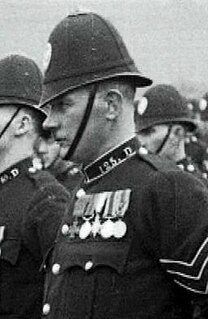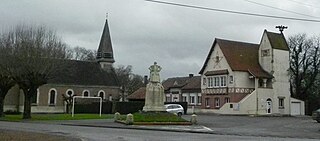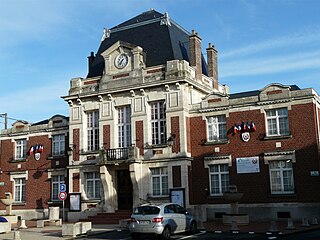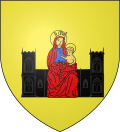
Cambrai, formerly Cambray and historically in English Camerick or Camericke, is a commune in the Nord department and in the Hauts-de-France region of France on the Scheldt river, which is known locally as the Escaut river.

The Battle of Cambrai was a British attack in the First World War, followed by the biggest German counter-attack against the British Expeditionary Force (BEF) since 1914. The town of Cambrai, in the département of Nord, was an important supply centre for the German Siegfriedstellung and capture of the town and the nearby Bourlon Ridge would threaten the rear of the German line to the north. Major General Henry Tudor, Commander, Royal Artillery (CRA), of the 9th (Scottish) Division, advocated the use of new artillery-infantry tactics on his sector of the front. During preparations, J. F. C. Fuller, a staff officer with the Tank Corps, looked for places to use tanks for raids. General Julian Byng, commander of the Third Army, decided to combine both plans. The French and British armies had used tanks en masse earlier in 1917, although to considerably less effect.

Field Marshal John Standish Surtees Prendergast Vereker, 6th Viscount Gort, was a senior British Army officer. As a young officer during the First World War he was decorated with the Victoria Cross for his actions during the Battle of the Canal du Nord. During the 1930s he served as Chief of the Imperial General Staff. He is best known for commanding the British Expeditionary Force that was sent to France in the first year of the Second World War, only to be evacuated from Dunkirk the following year. Gort later served as Governor of Gibraltar and Malta, and High Commissioner for Palestine and Transjordan.

The Battle of Arras was a British offensive on the Western Front during the First World War. From 9 April to 16 May 1917, British troops attacked German defences near the French city of Arras on the Western Front. The British achieved the longest advance since trench warfare had begun, surpassing the record set by the French Sixth Army on 1 July 1916. The British advance slowed in the next few days and the German defence recovered. The battle became a costly stalemate for both sides and by the end of the battle, the British Third Army and the First Army had suffered about 160,000 casualties and the German 6th Army about 125,000.

William Edgar Holmes VC was an English recipient of the Victoria Cross (VC), the highest and most prestigious award for gallantry in the face of the enemy that can be awarded to British and Commonwealth forces. A soldier with the Grenadier Guards during the First World War, he was posthumously awarded the VC for his actions on 9 October 1918, during the Hundred Days Offensive.

John Harold Rhodes VC DCM & Bar was an English recipient of the Victoria Cross, the highest and most prestigious award for gallantry in the face of the enemy that can be awarded to British and Commonwealth forces.

Thomas Norman Jackson VC was an English soldier of the British Expeditionary Force, and posthumous recipient of the Victoria Cross, the highest military award for gallantry in the face of the enemy given to British and Commonwealth forces, during the First World War.

John McAulay, was a Scottish policeman, soldier and recipient of the Victoria Cross, the highest award for gallantry in the face of the enemy that can be awarded to British and Commonwealth forces.

The Battle of Tannenberg Line or the Battle of the Blue Hills was a military engagement between the German Army Detachment Narwa and the Soviet Leningrad Front. They fought for the strategically important Narva Isthmus from 25 July–10 August 1944. The battle was fought on the Eastern Front during World War II. The strategic aim of the Soviet Estonian Operation was to reoccupy Estonia as a favorable base for the invasions of Finland and East Prussia. Waffen-SS forces included 24 volunteer infantry battalions from the SS Division Nordland, the SS Division Langemarck, the SS Division Nederland, and the Walloon Legion. Roughly half of the infantry consisted of the personnel of the 20th Waffen Grenadier Division of the SS. The German force of 22,250 men held off 136,830 Soviet troops. As the Soviet forces were constantly reinforced, their overall casualties are estimated by Estonian historian Mart Laar to be 170,000 dead and wounded.

Georg Cornelius Adalbert von der Marwitz was a Prussian cavalry general, who commanded several German armies during the First World War on both the Eastern and Western fronts.

The Second Battle of the Aisne was the main part of the Nivelle Offensive, a Franco-British attempt to inflict a decisive defeat on the German armies in France. The Entente strategy was to conduct offensives from north to south, beginning with an attack by the British Expeditionary Force (BEF) then the main attack by two French army groups on the Aisne. General Robert Nivelle planned the offensive in December 1916, after he replaced Joseph Joffre as Commander-in-Chief of the French Army.

Bullecourt is a commune in the Pas-de-Calais department in the Hauts-de-France region in France.

Havrincourt is a commune in the Pas-de-Calais department in Hauts-de-France in France. The inhabitants are called Havrincourtois.

The Battle of Canal du Nord was part of the Hundred Days Offensive of the First World War by the Allies against German positions on the Western Front. The battle took place in the Nord-Pas-de-Calais region of France, along an incomplete portion of the Canal du Nord and on the outskirts of Cambrai between 27 September and 1 October 1918. To prevent the Germans from sending reinforcements against one attack, the assault along the Canal du Nord was part of a sequence of Allied attacks at along the Western Front. The attack began the day after the Meuse-Argonne Offensive commenced, a day before an offensive in Belgian Flanders and two days before the Battle of St. Quentin Canal.
The 5th Guards Infantry Division was a division of the Royal Prussian Guards of the Imperial German Army. It was formed during World War I and dissolved with the demobilization of the German Army in 1919.

Masnières is a commune in the Nord department in northern France.

The Battle of Grand-Reng or Battle of Rouvroi saw a Republican French army jointly commanded by Louis Charbonnier and Jacques Desjardin attempt to advance across the Sambre River against a combined Habsburg Austrian and Dutch army under Franz Wenzel, Graf von Kaunitz-Rietberg. After winning crossings over the Sambre at Thuin and Lobbes on the 10th and Merbes-le-Château on the 12th, the French were defeated on 13 May at Grand-Reng and forced to retreat. The War of the First Coalition engagement marked the first of five attempts by the French armies to establish themselves on the north bank of the Sambre. Grand-Reng is now part of the village of Erquelinnes, Belgium, lying close to the border with France. Rouveroy (Rouvroi) is situated 3.8 kilometres (2.4 mi) north. Grand-Reng is located about 33 kilometres (21 mi) southwest of Charleroi.

The 2nd Battle of Longstop Hill or the Capture of Longstop Hill took place in Tunisia during the Tunisia Campaign of World War II from 21 to 23 April 1943. The battle was fought for control over the heights of Djebel el Ahmera and Djebel Rhar, together known as Longstop Hill and vicinity, between the British forces of the First Army and German units of the 5th Panzer Army. The infantry of the 78th Battleaxe Division and Churchill tanks of the North Irish Horse captured Longstop Hill after bitter fighting, in which the tanks created a measure of tactical surprise by driving up the hill, a manoeuvre that only Churchill tanks could achieve. The attackers broke through the German defences, which were the last great natural barrier on the road to Tunis.

The German attack on Lagnicourt on 15 April 1917. was a military operation on the Western Front during the First World War. Four German divisions conducted a spoiling attack on the positions of the 1st Anzac Corps of the British Fifth Army. The attack was intended to delay the advance of the Fifth Army towards the Hindenburg Line, cause as many casualties and destroy as much equipment, particularly artillery, as possible.























